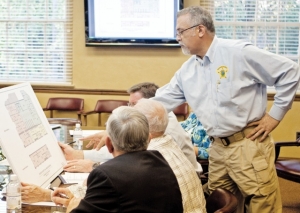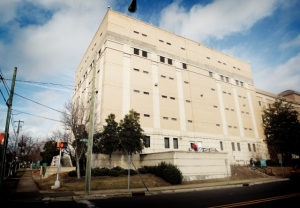Commissioners look at facilities
By Steve Herring
Published in News on January 30, 2013 1:46 PM

News-Argus/STEVE HERRING
Wayne County Sheriff's Office Maj. Fane Greenfield, right, points out aspects of a proposed $2.7 million renovation project at the former Services on Aging building that would add more than 40 jail beds. The proposal, and another that would close Chestnut Street near the county jail, were presented Tuesday at the county's Facilities Committee meeting. Committee members are, from left, Commissioners Ray Mayo, Wayne Aycock and Steve Keen.

Wayne County Jail
The Wayne County Facilities Committee met Tuesday and discussed ways to relieve overcrowding at the county jail.
One option, likely the cheapest, would be to renovate the old bank building, which until recently housed Services on Aging, to provide more jail beds. That cost would be about $3 million.
The most expensive option would be construction of an entirely new 500-bed jail at an estimated cost of $51 million.
Officials of the Brennan Group, a consulting firm, presented the options during the committee's session Tuesday afternoon at the Wayne County Development Alliance conference room.
The company was hired by the county to design and to manage renovations at the jail.
The Facilities Committee, chaired by Commissioner Ray Mayo, spent the better part of the meeting reviewing the 30-some facilities owned by the county before discussing the jail
Commissioners Steve Keen and Wayne Aycock also serve on the committee and were present, as was Commissioner Joe Daughtery.
Currently the jail is housing more than 220 inmates, while another 40-some are being held in other counties.
"This (option) takes the Day Reporting area, which is currently occupied, the bank building where the old senior center was, and basically we would renovate it to create new spaces -- an expanded area for Day Reporting, a 44-bed area to relieve some of your overcrowding," said Jim Brennan, president and CEO of the Brennan Group. "So the 40-some you are sending to other counties you could bring back to this facility.
"Even with that you would still be operating 20 to 30 over your limit. It doesn't solve it all, but it certainly does help relieve the problem. The other important thing here is that we created a video visitation center. This would allow visitors to come to that lobby area and through video visits actually conduct their visit with jail inmates without having to enter the secure perimeter of the building."
An added benefit to video visitation is that it strengthens security since staff would no longer have to escort inmates to various visitation areas, which would also lower operational costs, he said.
"You have private sector people going up to the sixth floor of your jail right now which is a mid-air collision just waiting to happen," said David Cruseturner, Brennan Management Services managing director. "That is a potential hostage situation. This would take care of that."
The video visitation could provide a revenue stream as well, he said.
"If I had someone incarcerated here in Wayne County, and I didn't want to come from Nashville, Tenn., I could use my VISA card and have a visit and the county can generate revenue off that," Cruseturner said.
Sheriff's Office Maj. Fane Greenfield, who oversees the jail, said video visitation could help with inmate control, too.
"My gang activity in the jail, I have so many murderers that I can't allow but certain people to come and see them. We have fights in the elevators from friends coming to see other friends. You don't know who you are putting on the elevators. You don't know who is coming. Sometimes they come in and you have a mess," Greenfield said. "This would keep the public from coming inside this secure area."
Another advantage is that it would help curtail contraband entering the jail, Sheriff Carey Winders said.
The design includes two isolation cells where inmates who cause problems could be kept overnight before being moved the following morning, Brennan said.
Keen asked Winders if the additional beds would mean the county would lower costs by no longer having to house inmates in other counties.
"You might be all right now for a little while," Winders said. "It is 44 beds and that is good. What you have to worry about is the future with legislative changes.
"It is going to help us, no doubt. I think we need it," Winders added. "You are going to save some money by having that. We don't know what the future holds, but one day eventually you are going to have to build a jail."
County Manager Lee Smith said the county would also like to expand its electronic monitoring program to help lower the jail population. Currently, the county has 40 monitoring machines and Smith said that he would like to double the number.
It would require hiring more people to monitor the machines. But instead of paying $50 per day to house an inmate, the monitoring cost is only about $7, he said.
Keen asked Brennan if they had looked at parking in the area around the Day Reporting Center. Parking was not considered and would need to be the focus of a long-range plan, Brennan said.
Keen also wanted to know if the building would be for one purpose only, and what would happen to it in 10 years if the county decided to do something different.
The video visitation could remain there, as well as Day Reporting, Brennan said. Also, the furniture in the inmate dormitory area could be moved elsewhere, leaving a large open room that could be used to expand other programs, he said.
Winders said that Wayne and other counties share a similar problem with one aspect of the jail population -- women. The Wayne jail currently has 30 women inmates and has a capacity of 36.
Even if space is available in other areas, women inmates cannot be housed with the men, he said.
"That could be another female center just for females," Winders said.
Construction cost would be just over $2.3 million. The county is currently paying about $130,000 annually to other counties to house its inmates -- money that would be saved by keeping them in the county, Brennan said. The savings would help ensure a quick payback, he noted.
The total project cost, that would include the video visitation center and other work, would be approximately $2.7 million.
Option No. 2 would add 256 beds by building a four-story addition to the existing jail. It would, however, call for Chestnut Street to be closed at the jail. Smith said that would require city approval. Years ago a similar closing was mentioned, but all city officials said was that it would have to be talked about, he said.
The other option would be to build on the other side of Chestnut Street and connect the two buildings by a skywalk, an idea committee members did not appear to support. The cost would be approximately $31 million.
Building an all-new 500 bed jail would increase the price tag to $51 million.
Winders said commissioners need to make sure the public understands that two other ideas he has been asked about are not practical.
The first is why the old Cherry Hospital property couldn't be renovated to serve as a jail. The cost would be just as great as building a new jail and the size would be smaller, Winders said. Also, it would increase transportation costs since inmates would have to be taken back and forth to court.
Nor, he said, can the county get by with keeping some inmates in tents, as is done in Maricopa County, Ariz.
"If you want the bad guys locked up, you have got to have a place to put them," Winders said.
